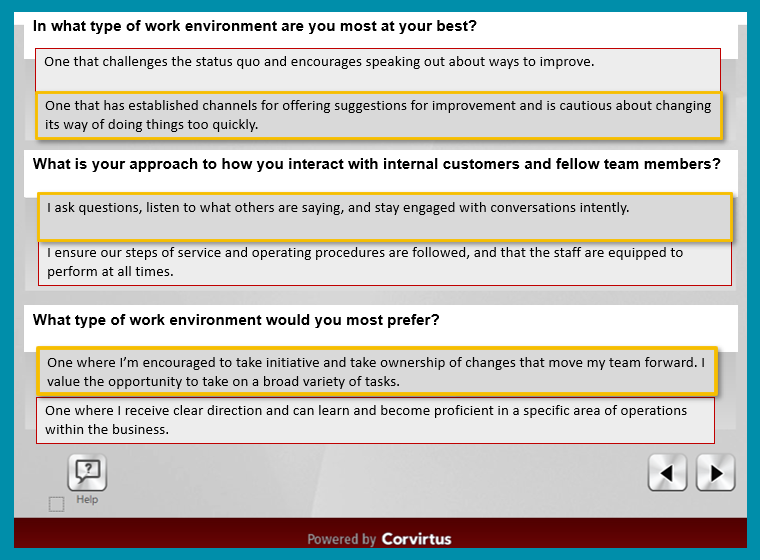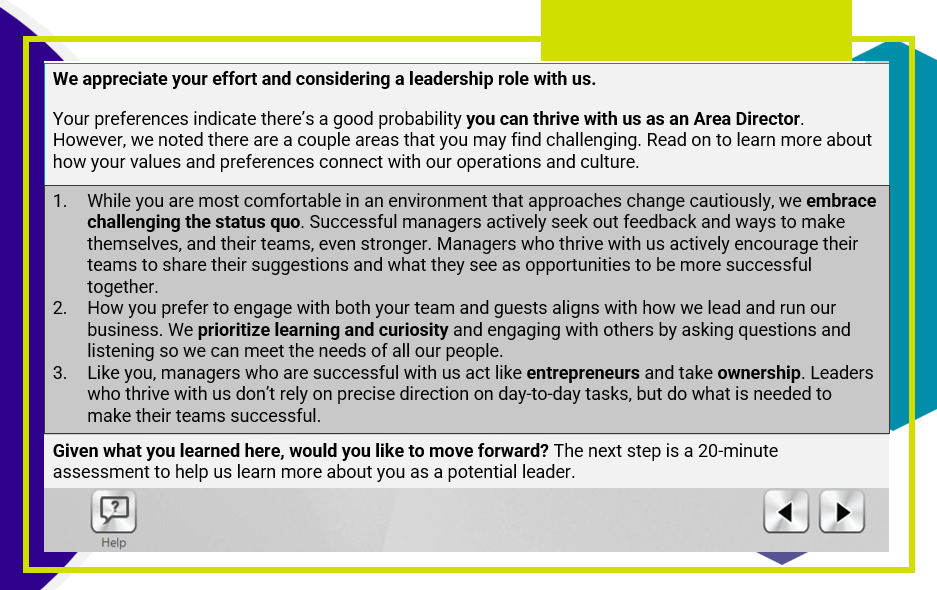Cover photo by Brett Jordan on Unsplash
The value of an engaging, interactive, and authentic candidate experience reaches far beyond the initial stages of recruiting. It's the foundation of a long-term relationship that builds shared expectations between the employer and the employee. By educating candidates and providing them with an authentic view into the role and culture, we're intentionally shaping the employee experience.
In this article, I'll walk through -
- Considering the goals of your candidate experience when building a Realistic Job Preview (RJP)
- Building an Authentic Employment Brand and Candidate Experience
- Applied practical research, and real examples, showing the ROI of RJPs in action
- Clear next steps for building and implementing Realistic Job Previews
We (and, okay, perhaps me, in particular) talk a lot about the numerous benefits of including a realistic job preview, often through automated online experiences, within the hiring process. Realistic job previews offer candidates a detailed and honest look at the day-to-day employee experience, including both the rewarding aspects and the potential challenges they might face. When done well, we're able to engage and educate on the main reasons we see people flourish and thrive and the expectations that frustrate us with revolving turnover.
What's a Realistic Job Preview?
While no single HR or recruiting technology can universally address this issue, realistic job previews are a frequently overlooked element of a comprehensive solution. RJPs offer candidates a range of experiences that provide a transparent and candid insight into the job's requirements, challenges, and culture, often before they fully engage in the application process.
Teams using our RJPs experience increased retention, enhanced engagement, and greater hiring efficiency. This happens through offering candidates a clear and honest preview of the role, highlighting both the benefits and challenges they will encounter. By doing so, we can foster trust, enhance retention, and attract employees who are genuinely well-suited for the position.
To deliver a realistic preview for candidates, we can employ various methods, such as:
- Videos that offer a glimpse into the work environment (particularly beneficial for roles in fast-paced kitchens or manufacturing settings), or employee testimonials that candidly discuss both the positive aspects and challenges they face daily. The United States' TSA has an exemplary model for security officers in this regard.
- Written testimonials and content that can be shared not only on your online careers page but also within the application process, and even included in physical brochures for job fairs or interviews.
- Simulations and assessments. These tools, often online, place candidates in critical scenarios they will encounter on the job or ask direct questions about their preferences and ideal working methods. With our solutions, candidates are typically informed that their responses will not be shared with the employer, allowing them to understand how their true preferences and goals align with the role. After receiving feedback, candidates are always welcome to proceed to the next step in the hiring process, regardless of their responses.
See an Realistic Job Preview in action.
While it's just my own experience, I can remember, with great clarity, taking the short interactive realistic job preview, and reviewing the written RJP, crafted by Corvirtus when I was hired over a decade ago. I can still remember evaluating the questions, shared information, and considering if I could thrive within the challenges and rewards of our culture. Now, as a leader, I've had meaningful discussions with candidates around our culture and ways of working.
We're hungry for information and certainty, especially when we're still in the early stages of the hiring process, like the application and assessment steps. Why not both support candidates by giving them information that will help them think deeply about the opportunity while also improve your odds of making a great hiring decision?
The authenticity delivered by a realistic job preview helps to soften a sharp fall in satisfaction from unmet expectations once the candidate transitions into the role. Realistic job previews set accurate expectations from the outset cutting the likelihood of disenchantment and falling commitment. which often occur when employees encounter unexpected facets of the job or company culture that were not clearly communicated during the hiring process.
If we're seeking to close the gap between expectations and reality, we'll be most effective if we know what the gaps are and how to close them. Seeking full understanding of the candidate experience first, before attempting to bridge any assumed gaps, is one of the best things you can do for your brand and candidate experience.
Here are some questions to begin the process of building a realistic job preview:
- First, what job groups are involved? If culture is the main focus, one job preview may be enough. However, if your culture is coming to life in ways that are unique for each job, then we may need to consider unique job previews (e.g., frontline employees, support center team).
- Next, gain an understanding of critical incidents around retention and a positive new hire experience: what are examples and events of great success and failure early in the employee journey? Interviews, focus groups, and existing records provide useful information.
-
If competencies are defined for this job group, identify what contributes to success or failure in those areas. Record the essential role requirements that frequently present challenges early in the employment. Consult with recruiters and hiring managers to determine what they find frustrating about candidates' lack of understanding, or more critically, what new hires fail to grasp or are not ready to execute.
This information will be key in creating an RJP that really captures what the job is all about and sets your organization apart as a trustworthy, genuine place that truly cares about the success and well-being of its employees.
What are the goals of your candidate experience?
Hint: It's not just telling them how great you are.
First, it’s understandable why we can hesitate do this. We're invested in our mission. We see and are connected to what makes us remarkable and can see our past selves excited about the opportunity. We're eager to communicate how we exceed the competition and create an unforgettable first impression.
So, you may ask “Why would I tell candidates the joys of the job sometimes come with stress and 50+ hour work weeks? When the top one percent of candidates deliver over 10 percent of results, why would I share anything negative that could cause them to leave?"
Building an Authentic Employment Brand and Candidate Experience
Authentically sharing about your culture, operations, mission, and expectations will differentiate your employment brand and create one that earns the trust of potential high performers. Differentiating your candidate experience and employment brand by showing a concern for your candidates making a fully informed and educated decision is more of a competitive key now than ever before.
Your employment brand is the full picture - not just the joys and points of celebration - but the tough challenges teams overcome that realize your vision and culture. Explaining your expectations openly in an interactive, scaled, and consistent way, like the realistic job preview above (or through other means like your website, videos, and shared information), seamlessly in your recruiting journey shows care, concern, and respect for every candidate.
In fact, using potential STEM educators as a population (where competition for talent is often high), realistic job previews and related exercises increased the rate at which candidates realistically envision the position and determine gaps between their preferences and core expectations. After the realistic job preview, respondents shared thinking more rigorously about the challenges of teaching, considering gaps in their own skills, (example: "I might not have the patience for that") and considering how they could best make an informed decision.
See a Realistic Job Preview in action.
In fact, other work on realistic job previews found -
- Reduced trauma and improved physical and mental well-being for direct care staff in emotionally demanding roles
- When used for unit selection for new nurses choosing between different specialties not only was there lower turnover but greater retention within the profession
Providing well-rounded information about your culture, for example, allows a candidate to see if your ways of working match their personal values and needs. Giving candidates a realistic understanding about working conditions and expectations that one does not typically see in generic job postings alleviates the uncertainty of the job search while giving them a sense of control.
Employer branding also involves communicating the unique strengths, vision, and rewards of your organization; by emphasizing both you can create a view of your enterprise that candidates perceive as authentic – and inspiring.
Realistic job previews also provide a consistent opportunity for hiring manager and recruiter follow-up. Build questions about the experience or information into your interviews.
"Do you remember sharing your preferences, or what you would do, in a series of questions and scenarios? What did you think of that? Can you share how you think you'd manage X-demand or Y-challenge on the job? How could I best support you?"
These touchpoints within the candidate experience made me feel respected and valued. They convey the exceptional care and intention we put into someone joining our team and our drive to make it a remarkable work experience. Similarly, as a leader they've contributed to meaningful conversations with candidates both learning about their potential and educating them on our expectations, culture, and core promises to and from teammates.
How to make it happen?
We've developed several realistic job previews for organizations across industries and sizes - including ones hard hit by talent shortages like healthcare and restaurants. We usually build an interactive assessment, like the one above, that educates the candidates on their strengths and gaps compared to job demands, expectations, and culture.
The goal is to frame the difficult job demands that future candidates need to understand, and that often lead to turnover and struggling to thrive. Candidates are invited to complete the next step of the hiring process, usually a scored validated pre-hire assessment, regardless of their performance on the realistic job preview.
The online experience connects with the interview process and we often build other pieces to complement the process like website content and videos.
Usually the content for the preview experience comes from objective and qualitative data gathering on your culture and expectations. This could be through our quick CultureMap process (a short survey, usually deployed to leaders, to isolate expectations for action, caring for stakeholders, competition, maintaining uniqueness, and viewing results), and/or short one hour focus group conversations with leaders and strong team members.
In conclusion, building realistic job previews and embedding them into your hiring process is not just a strategic win but a core step in building authenticity - and an employment brand and culture people believe in. By providing candidates with a comprehensive view of the role and your culture, you set them on a path to making informed decisions. In a world where nearly half of new hires regret their decision, you're taking steps to build trust and respect, ultimately contributing to a more committed workforce. As you embark on this journey, remember that the authenticity and depth of your candidate experience can only happen by knowing the authentic beliefs and experience of your new hires and candidates today.
Begin building an authentic candidate experience.
Receive our eBook on building a powerful evidence-driven hiring process and an example realistic job preview.

.png?width=675&height=675&name=Blog%20Quote%20%20(3).png)

.png?width=768&height=576&name=Four%20Part%20Diagrams%20-%20blogs%20and%20things%20(1).png)




